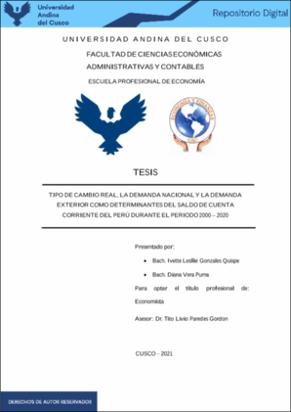| dc.contributor.advisor | Paredes Gordón, Tito Livio | |
| dc.contributor.author | Gonzales Quispe, Ivette Lesllie | |
| dc.contributor.author | Vera Puma, Diana | |
| dc.date.accessioned | 2022-10-11T15:46:39Z | |
| dc.date.available | 2022-10-11T15:46:39Z | |
| dc.date.issued | 2022-03-16 | |
| dc.identifier.uri | https://hdl.handle.net/20.500.12557/4889 | |
| dc.description.abstract | La investigación busca analizar y determinar la influencia del tipo de cambio real,
demanda nacional y la demanda exterior en el saldo de cuenta corriente de la economía
peruana durante el periodo 2000 al 2020. La información utilizada es de fuentes oficiales
garantizadas; la cual primero es tratada en forma descriptiva aplicando la estática
comparativa, analizando el comportamiento de las variables que explican el problema,
relevando el rol y comportamiento de cada una de ellas para los cuatro quinquenios del
periodo de análisis, contrastando se evolución con el estilo de política económica y
hechos que impactan en el comercio exterior del Perú para cada tramo. Luego en la
perspectiva planteada por Krugman se adapta un modelo económico que sustenta el
análisis dinámico mediante un procedimiento econométrico, con la finalidad de
determinar la influencia de las variables independientes sobre el SCC; estimando la
magnitud en que el tipo de cambio real, la demanda nacional y la demanda exterior
inciden en el saldo de cuenta corriente. Con respecto al periodo 2000 al 2020 se observa
un déficit promedio anual de -2,841 millones de dólares, esto es consecuencia del alto
grado de propensión a importar de 25% del PBI que caracteriza a la economía peruana.
En cuanto al tipo de cambio real se observó que durante este periodo tuvo una volatilidad
promedio anual de 0.4%, mientras que la evolución de la demanda nacional presenta una
tasa de crecimiento promedio anual de 7.2% y finalmente la evolución de la demanda
exterior de nuestros principales socios comerciales presenta una tasa de crecimiento
promedio anua de 4.2%. Con la demostración econométrica identificamos que la
demanda interna del Perú es la que incide en mayor cuantía sobre el SCC, si esta se
incrementa en 1% el SCC aumenta en 29,345 Millones de dólares; en segundo lugar,
tenemos al Tipo de cambio real, si se incrementa en un sol por dólar, el SCC mejora en
9,954 millones de dólares; por lo contrario, la demanda externa tiene una incidencia
negativa, que al incrementarse en 1%, el SCC disminuye en 21,049 millones de dólares | es_PE |
| dc.description.abstract | The research seeks to analyze and determine the influence of the real exchange
rate, national demand and foreign demand on the current account balance of the Peruvian
economy during the period 2000 to 2020. The information used is from guaranteed
official sources; which is first treated descriptively by applying comparative statics,
analyzing the behavior of the variables that explain the problem, highlighting the role and
behavior of each of them for the four five-year periods of the analysis period, contrasting
its evolution with the style of economic policy and events that impact Peru's foreign trade
for each section. Then, in the perspective proposed by Krugman, an economic model is
adapted that supports the dynamic analysis through an econometric procedure, in order to
determine the influence of the independent variables on the SCC; estimating the
magnitude in which the real exchange rate, domestic demand and foreign demand affect
the current account balance. With respect to the period 2000 to 2020, an average annual
deficit of -2,841 million dollars is observed, this is a consequence of the high degree of
propensity to import of 25% of GDP that characterizes the Peruvian economy. Regarding
the real exchange rate, it was observed that during this period it had an average annual
volatility of 0.4%, while the evolution of the national demand presents an average annual
growth rate of 7.2% and finally the evolution of the foreign demand for Our main business
partners show an average annual growth rate of 4.2%. With the econometric
demonstration we identify that the internal demand of Peru is the one that has the greatest
impact on the SCC, if it increases by 1% the SCC increases by 29,345 million dollars;
secondly, we have the real exchange rate, which if it increases by one sol per dollar, the
SCC improves by 9,954 million dollars; on the contrary, external demand has a negative
impact, which when increased by 1%, the SCC decreases by 21,049 million dollars. | en_US |
| dc.format | application/pdf | es_PE |
| dc.language.iso | spa | es_PE |
| dc.publisher | Universidad Andina del Cusco | es_PE |
| dc.rights | info:eu-repo/semantics/openAccess | es_PE |
| dc.rights.uri | https://creativecommons.org/licenses/by-nc-nd/4.0/ | es_PE |
| dc.subject | Exportaciones | es_PE |
| dc.subject | Importaciones | es_PE |
| dc.subject | Saldo de cuenta corriente | es_PE |
| dc.title | Tipo de cambio real, la demanda nacional y la demanda exterior como determinantes del saldo de cuenta corriente del Perú durante el periodo 2000 – 2020 | es_PE |
| dc.type | info:eu-repo/semantics/bachelorThesis | es_PE |
| thesis.degree.name | Economista | es_PE |
| thesis.degree.grantor | Universidad Andina del Cusco. Facultad de Ciencias Económicas, Administrativas y Contables | es_PE |
| thesis.degree.discipline | Economía | es_PE |
| dc.publisher.country | PE | es_PE |
| dc.subject.ocde | https://purl.org/pe-repo/ocde/ford#5.02.01 | es_PE |
| renati.advisor.dni | 23800907 | |
| renati.advisor.orcid | https://orcid.org/0000-0001-6024-8209 | es_PE |
| renati.author.dni | 70458029 | |
| renati.author.dni | 72838212 | |
| renati.discipline | 311016 | es_PE |
| renati.juror | Castro Ponce de León, Ricardo | |
| renati.juror | Flórez Lucana, Ignacio Ramiro | |
| renati.juror | Martínez Rojas, Erick Mijail | |
| renati.juror | López Garcés, Oscar | |
| renati.level | https://purl.org/pe-repo/renati/level#tituloProfesional | es_PE |
| renati.type | https://purl.org/pe-repo/renati/type#tesis | es_PE |


